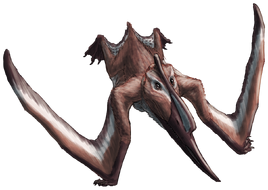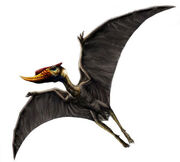
Dsungaripterus was a genus of pterosaur, with an average wingspan of 3 metres (9.8 ft). It lived during the Early Cretaceous, in China, where the first fossil was found in the Junggar Basin.
Discovery and species[]
Dsungaripterus was in 1964 named by Yang Zhongjian. The genus name combines a reference to the Junggar Basin with a Latinized Greek pteron, "wing". The type species is Dsungaripterus weii, the specific name honouring paleontologist C.M. Wei of the Palaeontological Division, Institute of Science, Bureau of Petroleum of Sinkiang. The holotype is IVPP No. V-2776, a partial skull and skeleton. From 1973 more material has been found including almost complete skulls.
In 1980 Peter Galton renamed Pterodactylus brancai (Reck 1931), a form from a late Jurassic African formation, into Dsungaripterus brancai, but the identification is now commonly rejected. In 1982 Natasha Bakhurina named a new species, Dsungaripterus parvus, based on a smaller skeleton from Mongolia. Later this was renamed into "Phobetor", a preoccupied name, and in 2009 concluded to be identical to Noripterus. In 2002 a Dsungaripterus wing finger phalanx was reported from Korea.
Appearance[]

Dsungaripterus weii had a wing span of 3 to 3.5 metres (9.8-11.5 ft). Its skull, 40 to 50 centimetres long, bore a low bone crest that ran down from the base of the skull to halfway to the beak. Dsungaripterus's head and neck were together almost a meter long. Its most notable feature are its long, narrow, upcurved jaws with a pointed tip, making the animal look like a pair of flying tweezers. It had no teeth in the front part of its jaws, which were probably used to remove shellfish and worms from cracks in rocks or/and the sandy, muddy beaches it inhabited. It had knobbly flat teeth more to the back of the jaw that were well suited for crushing the armor of shellfish.